Planning and Management Report: University Course Promotion
VerifiedAdded on 2022/11/24
|17
|4066
|253
Report
AI Summary
This report details a university course promotion and recruitment campaign, encompassing the development of marketing materials, community outreach, and applicant interviews. It applies various project management tools and methodologies, including project lifecycle, stakeholder analysis, and work breakdown structures. The report analyzes each phase of the project, from initiation and planning to execution and closure, highlighting the roles of different team members based on the Belbin model. It employs tools like Gantt charts and network diagrams to visualize timelines and dependencies. The report also assesses project management competencies and provides recommendations for future improvements, offering a comprehensive view of the planning and management processes involved in the campaign.
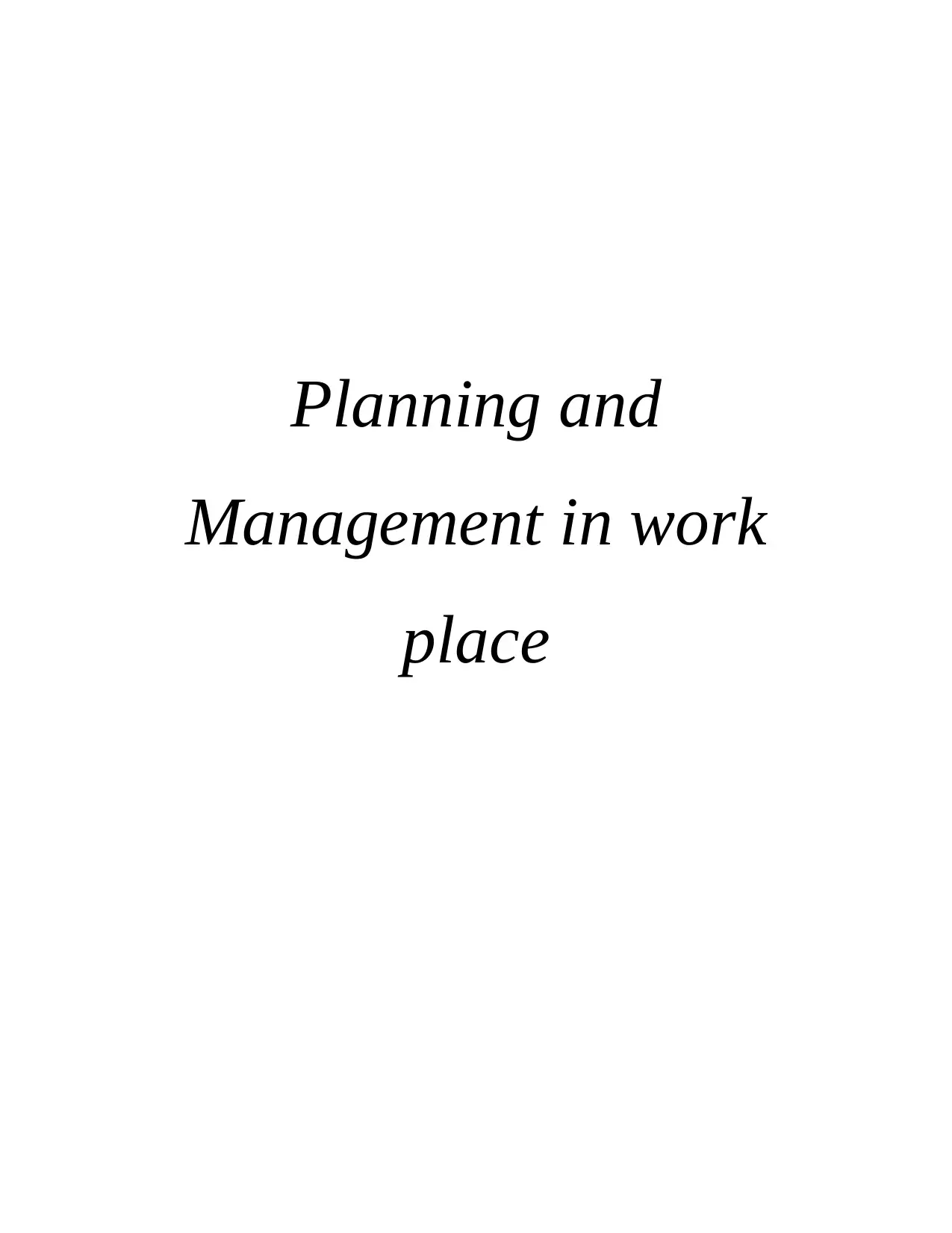
Planning and
Management in work
place
Management in work
place
Paraphrase This Document
Need a fresh take? Get an instant paraphrase of this document with our AI Paraphraser
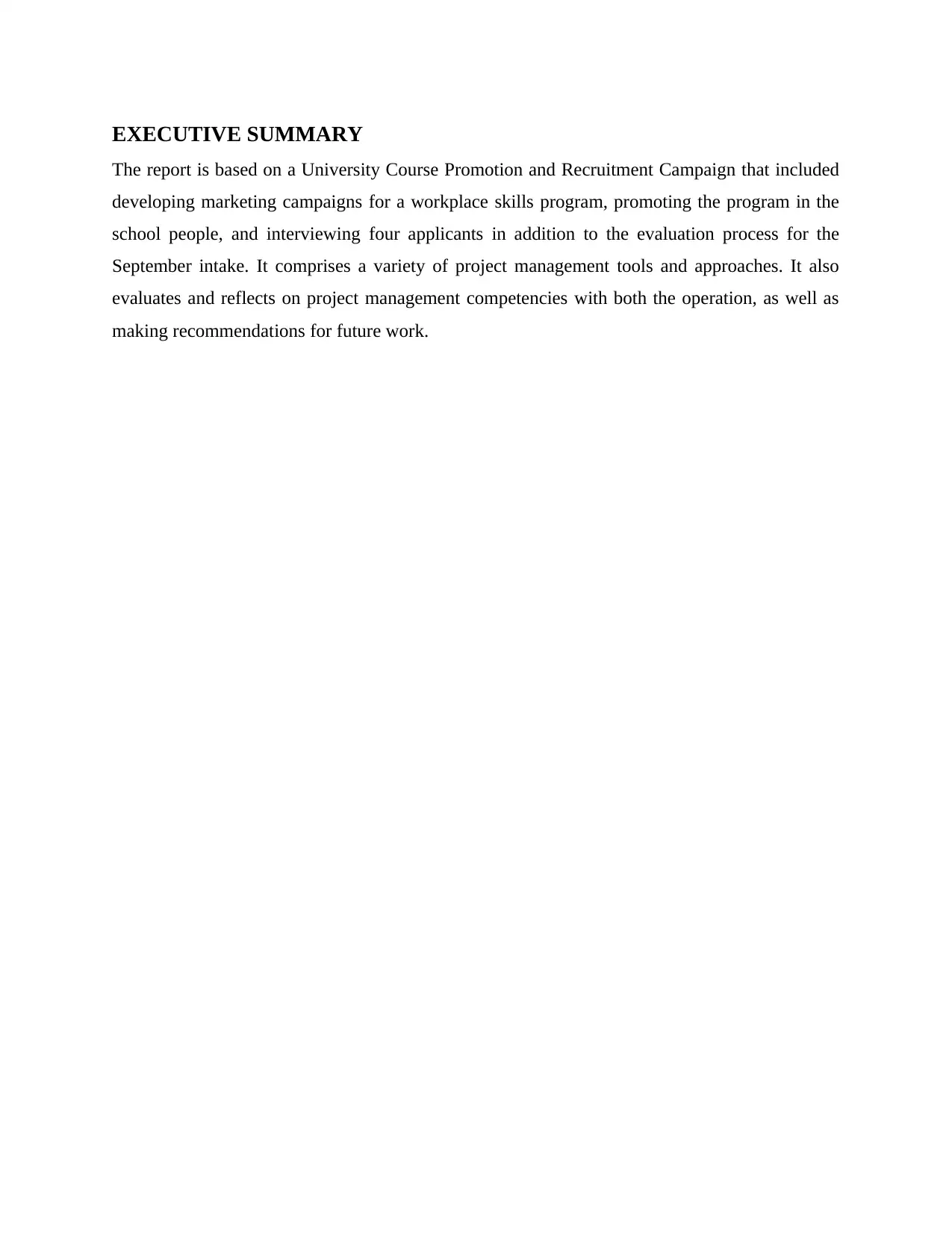
EXECUTIVE SUMMARY
The report is based on a University Course Promotion and Recruitment Campaign that included
developing marketing campaigns for a workplace skills program, promoting the program in the
school people, and interviewing four applicants in addition to the evaluation process for the
September intake. It comprises a variety of project management tools and approaches. It also
evaluates and reflects on project management competencies with both the operation, as well as
making recommendations for future work.
The report is based on a University Course Promotion and Recruitment Campaign that included
developing marketing campaigns for a workplace skills program, promoting the program in the
school people, and interviewing four applicants in addition to the evaluation process for the
September intake. It comprises a variety of project management tools and approaches. It also
evaluates and reflects on project management competencies with both the operation, as well as
making recommendations for future work.
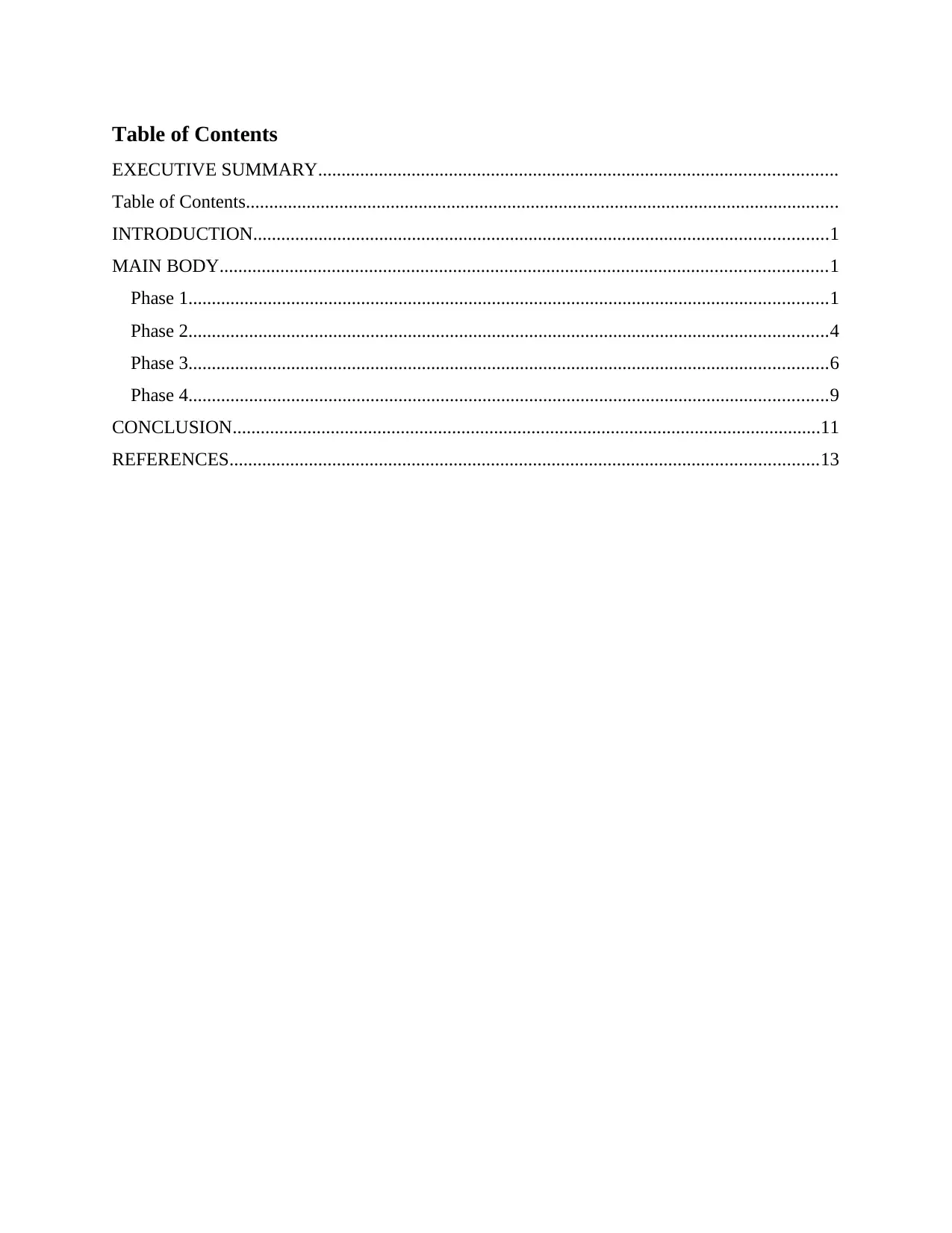
Table of Contents
EXECUTIVE SUMMARY...............................................................................................................
Table of Contents...............................................................................................................................
INTRODUCTION...........................................................................................................................1
MAIN BODY..................................................................................................................................1
Phase 1.........................................................................................................................................1
Phase 2.........................................................................................................................................4
Phase 3.........................................................................................................................................6
Phase 4.........................................................................................................................................9
CONCLUSION..............................................................................................................................11
REFERENCES..............................................................................................................................13
EXECUTIVE SUMMARY...............................................................................................................
Table of Contents...............................................................................................................................
INTRODUCTION...........................................................................................................................1
MAIN BODY..................................................................................................................................1
Phase 1.........................................................................................................................................1
Phase 2.........................................................................................................................................4
Phase 3.........................................................................................................................................6
Phase 4.........................................................................................................................................9
CONCLUSION..............................................................................................................................11
REFERENCES..............................................................................................................................13
⊘ This is a preview!⊘
Do you want full access?
Subscribe today to unlock all pages.

Trusted by 1+ million students worldwide
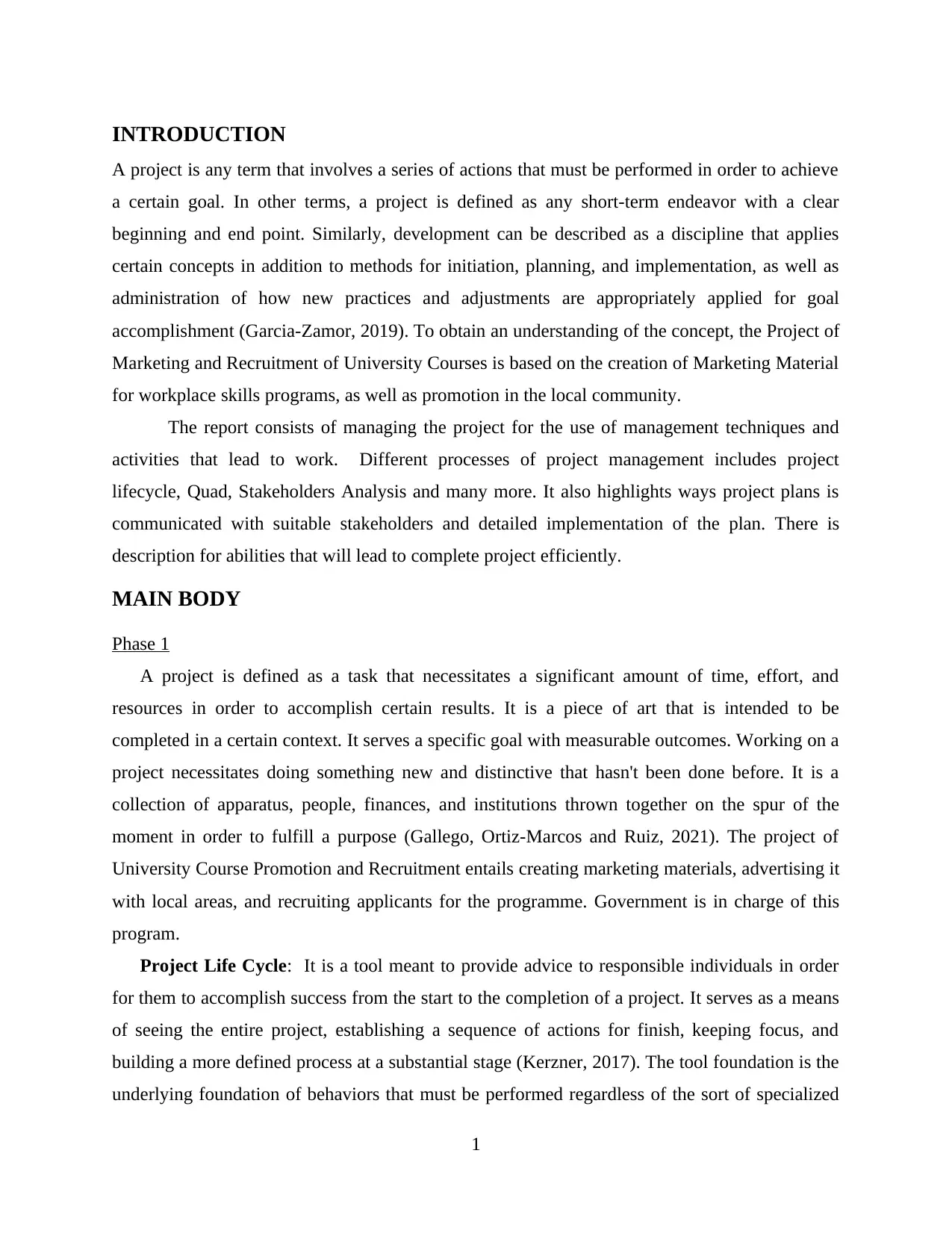
INTRODUCTION
A project is any term that involves a series of actions that must be performed in order to achieve
a certain goal. In other terms, a project is defined as any short-term endeavor with a clear
beginning and end point. Similarly, development can be described as a discipline that applies
certain concepts in addition to methods for initiation, planning, and implementation, as well as
administration of how new practices and adjustments are appropriately applied for goal
accomplishment (Garcia-Zamor, 2019). To obtain an understanding of the concept, the Project of
Marketing and Recruitment of University Courses is based on the creation of Marketing Material
for workplace skills programs, as well as promotion in the local community.
The report consists of managing the project for the use of management techniques and
activities that lead to work. Different processes of project management includes project
lifecycle, Quad, Stakeholders Analysis and many more. It also highlights ways project plans is
communicated with suitable stakeholders and detailed implementation of the plan. There is
description for abilities that will lead to complete project efficiently.
MAIN BODY
Phase 1
A project is defined as a task that necessitates a significant amount of time, effort, and
resources in order to accomplish certain results. It is a piece of art that is intended to be
completed in a certain context. It serves a specific goal with measurable outcomes. Working on a
project necessitates doing something new and distinctive that hasn't been done before. It is a
collection of apparatus, people, finances, and institutions thrown together on the spur of the
moment in order to fulfill a purpose (Gallego, Ortiz-Marcos and Ruiz, 2021). The project of
University Course Promotion and Recruitment entails creating marketing materials, advertising it
with local areas, and recruiting applicants for the programme. Government is in charge of this
program.
Project Life Cycle: It is a tool meant to provide advice to responsible individuals in order
for them to accomplish success from the start to the completion of a project. It serves as a means
of seeing the entire project, establishing a sequence of actions for finish, keeping focus, and
building a more defined process at a substantial stage (Kerzner, 2017). The tool foundation is the
underlying foundation of behaviors that must be performed regardless of the sort of specialized
1
A project is any term that involves a series of actions that must be performed in order to achieve
a certain goal. In other terms, a project is defined as any short-term endeavor with a clear
beginning and end point. Similarly, development can be described as a discipline that applies
certain concepts in addition to methods for initiation, planning, and implementation, as well as
administration of how new practices and adjustments are appropriately applied for goal
accomplishment (Garcia-Zamor, 2019). To obtain an understanding of the concept, the Project of
Marketing and Recruitment of University Courses is based on the creation of Marketing Material
for workplace skills programs, as well as promotion in the local community.
The report consists of managing the project for the use of management techniques and
activities that lead to work. Different processes of project management includes project
lifecycle, Quad, Stakeholders Analysis and many more. It also highlights ways project plans is
communicated with suitable stakeholders and detailed implementation of the plan. There is
description for abilities that will lead to complete project efficiently.
MAIN BODY
Phase 1
A project is defined as a task that necessitates a significant amount of time, effort, and
resources in order to accomplish certain results. It is a piece of art that is intended to be
completed in a certain context. It serves a specific goal with measurable outcomes. Working on a
project necessitates doing something new and distinctive that hasn't been done before. It is a
collection of apparatus, people, finances, and institutions thrown together on the spur of the
moment in order to fulfill a purpose (Gallego, Ortiz-Marcos and Ruiz, 2021). The project of
University Course Promotion and Recruitment entails creating marketing materials, advertising it
with local areas, and recruiting applicants for the programme. Government is in charge of this
program.
Project Life Cycle: It is a tool meant to provide advice to responsible individuals in order
for them to accomplish success from the start to the completion of a project. It serves as a means
of seeing the entire project, establishing a sequence of actions for finish, keeping focus, and
building a more defined process at a substantial stage (Kerzner, 2017). The tool foundation is the
underlying foundation of behaviors that must be performed regardless of the sort of specialized
1
Paraphrase This Document
Need a fresh take? Get an instant paraphrase of this document with our AI Paraphraser
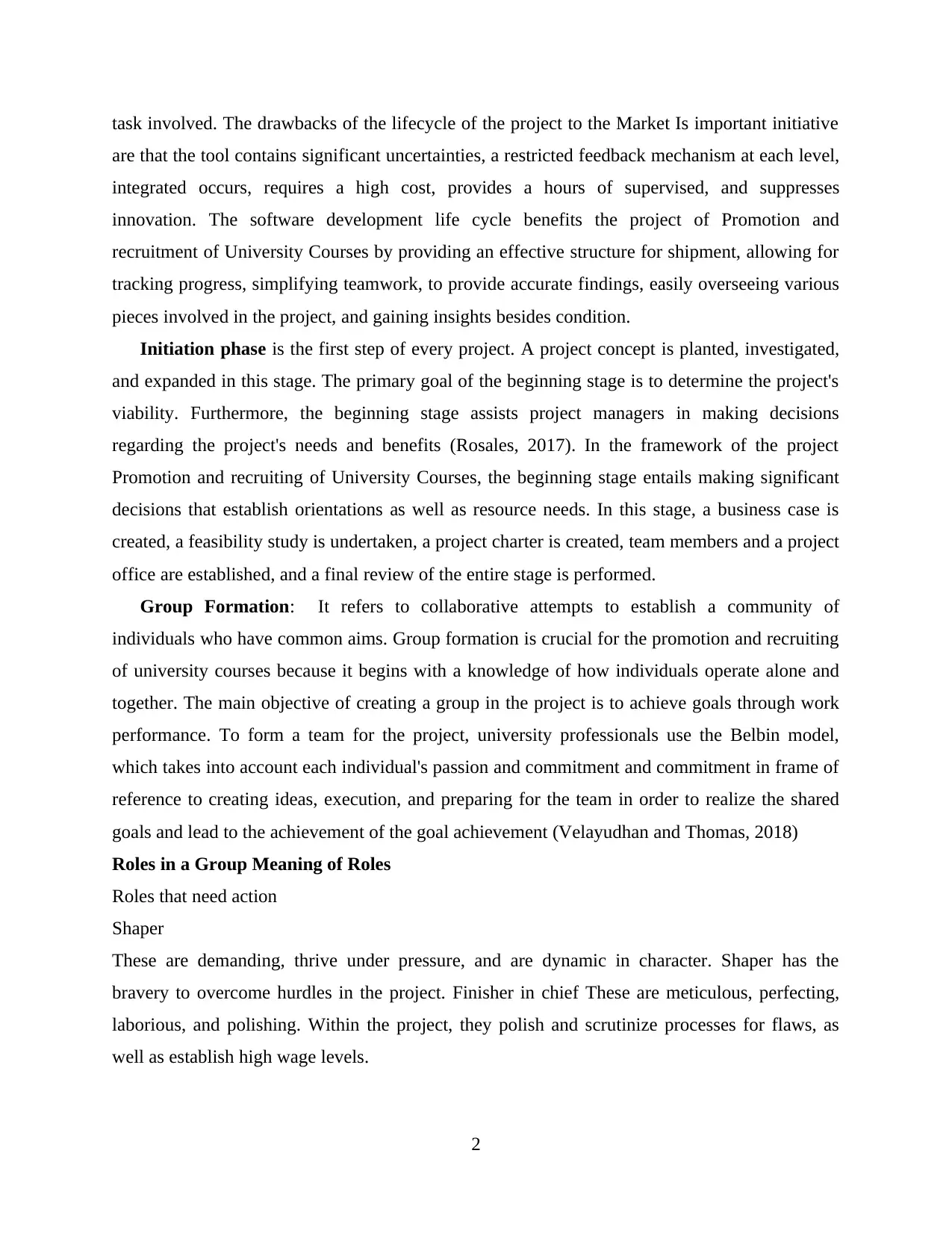
task involved. The drawbacks of the lifecycle of the project to the Market Is important initiative
are that the tool contains significant uncertainties, a restricted feedback mechanism at each level,
integrated occurs, requires a high cost, provides a hours of supervised, and suppresses
innovation. The software development life cycle benefits the project of Promotion and
recruitment of University Courses by providing an effective structure for shipment, allowing for
tracking progress, simplifying teamwork, to provide accurate findings, easily overseeing various
pieces involved in the project, and gaining insights besides condition.
Initiation phase is the first step of every project. A project concept is planted, investigated,
and expanded in this stage. The primary goal of the beginning stage is to determine the project's
viability. Furthermore, the beginning stage assists project managers in making decisions
regarding the project's needs and benefits (Rosales, 2017). In the framework of the project
Promotion and recruiting of University Courses, the beginning stage entails making significant
decisions that establish orientations as well as resource needs. In this stage, a business case is
created, a feasibility study is undertaken, a project charter is created, team members and a project
office are established, and a final review of the entire stage is performed.
Group Formation: It refers to collaborative attempts to establish a community of
individuals who have common aims. Group formation is crucial for the promotion and recruiting
of university courses because it begins with a knowledge of how individuals operate alone and
together. The main objective of creating a group in the project is to achieve goals through work
performance. To form a team for the project, university professionals use the Belbin model,
which takes into account each individual's passion and commitment and commitment in frame of
reference to creating ideas, execution, and preparing for the team in order to realize the shared
goals and lead to the achievement of the goal achievement (Velayudhan and Thomas, 2018)
Roles in a Group Meaning of Roles
Roles that need action
Shaper
These are demanding, thrive under pressure, and are dynamic in character. Shaper has the
bravery to overcome hurdles in the project. Finisher in chief These are meticulous, perfecting,
laborious, and polishing. Within the project, they polish and scrutinize processes for flaws, as
well as establish high wage levels.
2
are that the tool contains significant uncertainties, a restricted feedback mechanism at each level,
integrated occurs, requires a high cost, provides a hours of supervised, and suppresses
innovation. The software development life cycle benefits the project of Promotion and
recruitment of University Courses by providing an effective structure for shipment, allowing for
tracking progress, simplifying teamwork, to provide accurate findings, easily overseeing various
pieces involved in the project, and gaining insights besides condition.
Initiation phase is the first step of every project. A project concept is planted, investigated,
and expanded in this stage. The primary goal of the beginning stage is to determine the project's
viability. Furthermore, the beginning stage assists project managers in making decisions
regarding the project's needs and benefits (Rosales, 2017). In the framework of the project
Promotion and recruiting of University Courses, the beginning stage entails making significant
decisions that establish orientations as well as resource needs. In this stage, a business case is
created, a feasibility study is undertaken, a project charter is created, team members and a project
office are established, and a final review of the entire stage is performed.
Group Formation: It refers to collaborative attempts to establish a community of
individuals who have common aims. Group formation is crucial for the promotion and recruiting
of university courses because it begins with a knowledge of how individuals operate alone and
together. The main objective of creating a group in the project is to achieve goals through work
performance. To form a team for the project, university professionals use the Belbin model,
which takes into account each individual's passion and commitment and commitment in frame of
reference to creating ideas, execution, and preparing for the team in order to realize the shared
goals and lead to the achievement of the goal achievement (Velayudhan and Thomas, 2018)
Roles in a Group Meaning of Roles
Roles that need action
Shaper
These are demanding, thrive under pressure, and are dynamic in character. Shaper has the
bravery to overcome hurdles in the project. Finisher in chief These are meticulous, perfecting,
laborious, and polishing. Within the project, they polish and scrutinize processes for flaws, as
well as establish high wage levels.
2
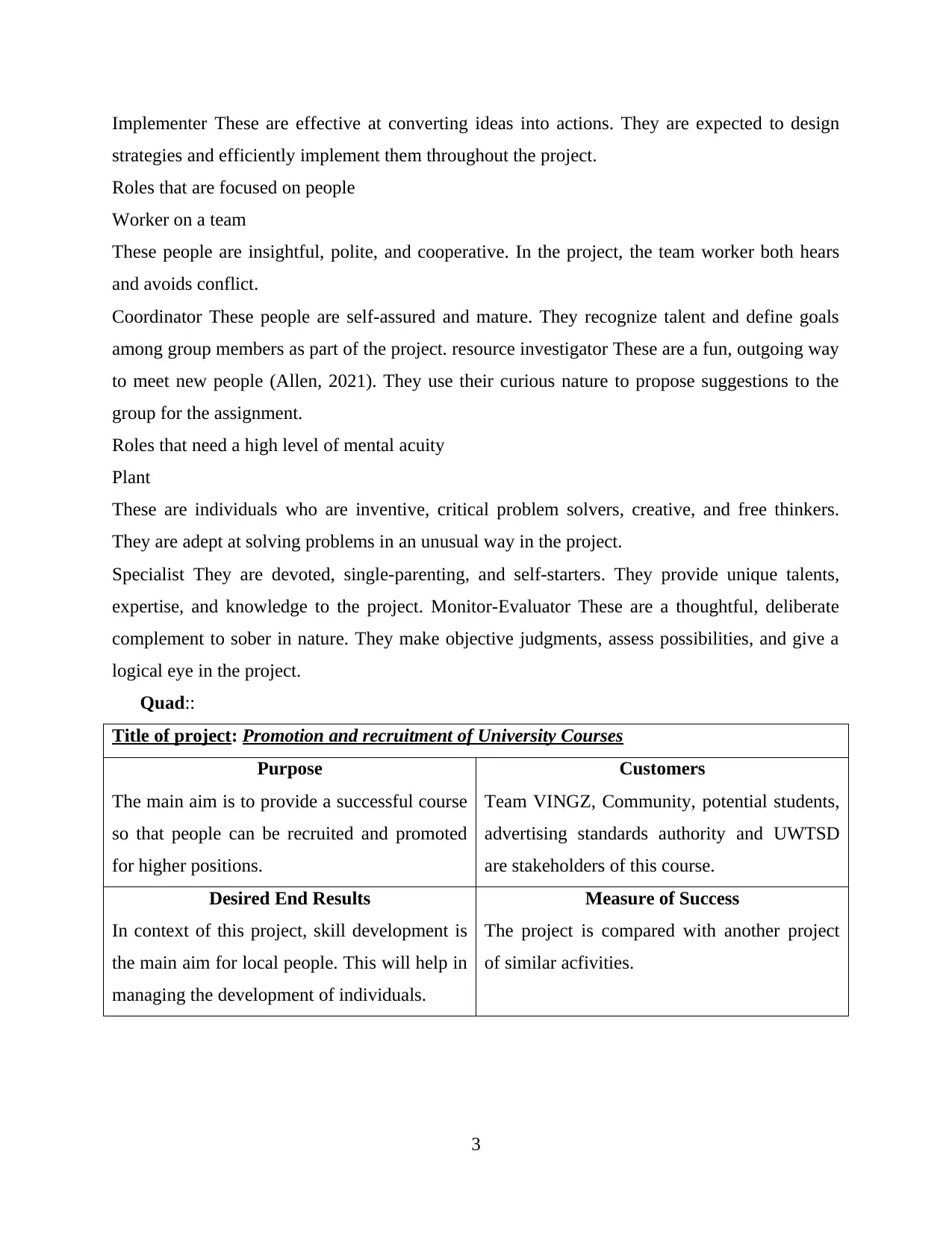
Implementer These are effective at converting ideas into actions. They are expected to design
strategies and efficiently implement them throughout the project.
Roles that are focused on people
Worker on a team
These people are insightful, polite, and cooperative. In the project, the team worker both hears
and avoids conflict.
Coordinator These people are self-assured and mature. They recognize talent and define goals
among group members as part of the project. resource investigator These are a fun, outgoing way
to meet new people (Allen, 2021). They use their curious nature to propose suggestions to the
group for the assignment.
Roles that need a high level of mental acuity
Plant
These are individuals who are inventive, critical problem solvers, creative, and free thinkers.
They are adept at solving problems in an unusual way in the project.
Specialist They are devoted, single-parenting, and self-starters. They provide unique talents,
expertise, and knowledge to the project. Monitor-Evaluator These are a thoughtful, deliberate
complement to sober in nature. They make objective judgments, assess possibilities, and give a
logical eye in the project.
Quad::
Title of project: Promotion and recruitment of University Courses
Purpose
The main aim is to provide a successful course
so that people can be recruited and promoted
for higher positions.
Customers
Team VINGZ, Community, potential students,
advertising standards authority and UWTSD
are stakeholders of this course.
Desired End Results
In context of this project, skill development is
the main aim for local people. This will help in
managing the development of individuals.
Measure of Success
The project is compared with another project
of similar acfivities.
3
strategies and efficiently implement them throughout the project.
Roles that are focused on people
Worker on a team
These people are insightful, polite, and cooperative. In the project, the team worker both hears
and avoids conflict.
Coordinator These people are self-assured and mature. They recognize talent and define goals
among group members as part of the project. resource investigator These are a fun, outgoing way
to meet new people (Allen, 2021). They use their curious nature to propose suggestions to the
group for the assignment.
Roles that need a high level of mental acuity
Plant
These are individuals who are inventive, critical problem solvers, creative, and free thinkers.
They are adept at solving problems in an unusual way in the project.
Specialist They are devoted, single-parenting, and self-starters. They provide unique talents,
expertise, and knowledge to the project. Monitor-Evaluator These are a thoughtful, deliberate
complement to sober in nature. They make objective judgments, assess possibilities, and give a
logical eye in the project.
Quad::
Title of project: Promotion and recruitment of University Courses
Purpose
The main aim is to provide a successful course
so that people can be recruited and promoted
for higher positions.
Customers
Team VINGZ, Community, potential students,
advertising standards authority and UWTSD
are stakeholders of this course.
Desired End Results
In context of this project, skill development is
the main aim for local people. This will help in
managing the development of individuals.
Measure of Success
The project is compared with another project
of similar acfivities.
3
⊘ This is a preview!⊘
Do you want full access?
Subscribe today to unlock all pages.

Trusted by 1+ million students worldwide
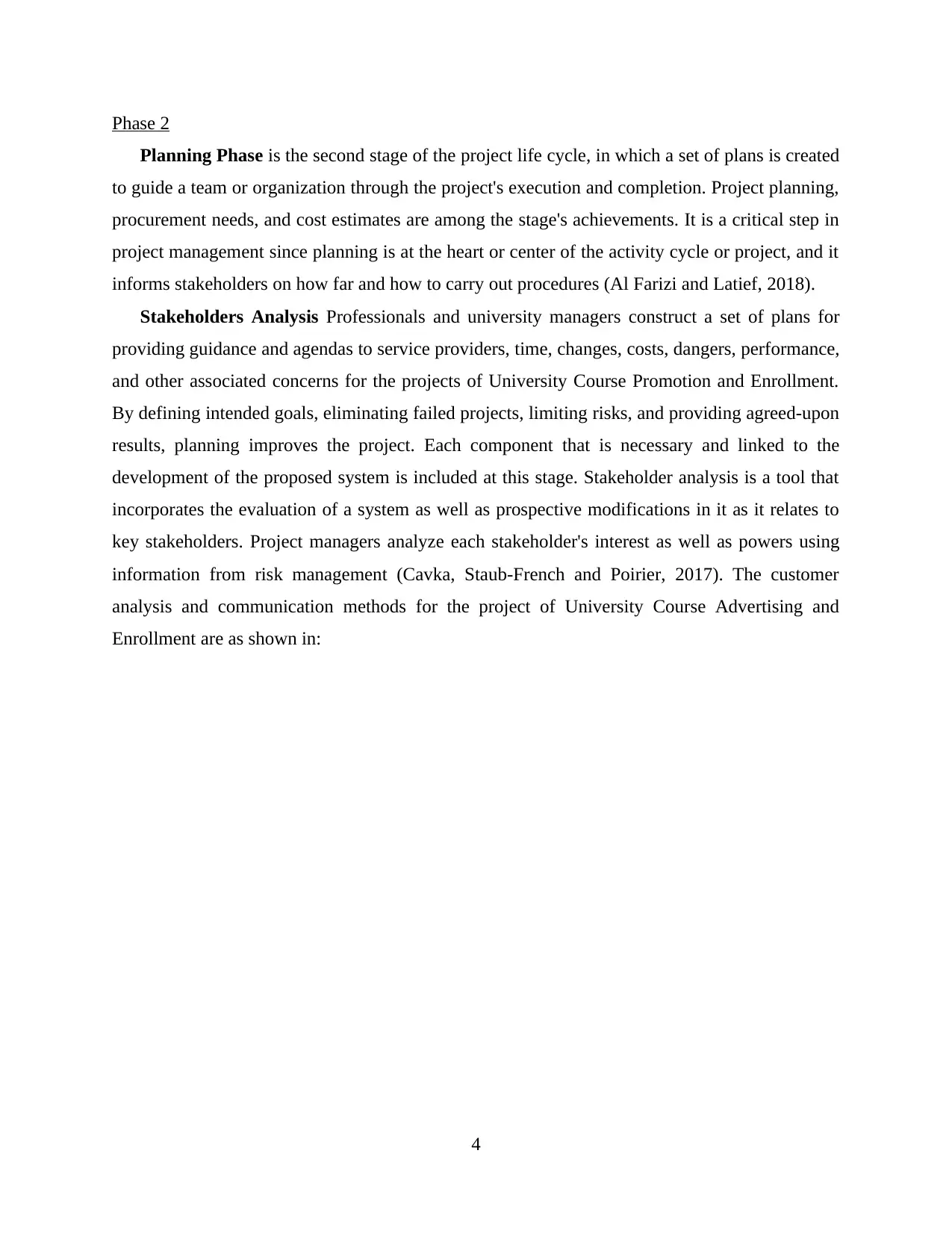
Phase 2
Planning Phase is the second stage of the project life cycle, in which a set of plans is created
to guide a team or organization through the project's execution and completion. Project planning,
procurement needs, and cost estimates are among the stage's achievements. It is a critical step in
project management since planning is at the heart or center of the activity cycle or project, and it
informs stakeholders on how far and how to carry out procedures (Al Farizi and Latief, 2018).
Stakeholders Analysis Professionals and university managers construct a set of plans for
providing guidance and agendas to service providers, time, changes, costs, dangers, performance,
and other associated concerns for the projects of University Course Promotion and Enrollment.
By defining intended goals, eliminating failed projects, limiting risks, and providing agreed-upon
results, planning improves the project. Each component that is necessary and linked to the
development of the proposed system is included at this stage. Stakeholder analysis is a tool that
incorporates the evaluation of a system as well as prospective modifications in it as it relates to
key stakeholders. Project managers analyze each stakeholder's interest as well as powers using
information from risk management (Cavka, Staub-French and Poirier, 2017). The customer
analysis and communication methods for the project of University Course Advertising and
Enrollment are as shown in:
4
Planning Phase is the second stage of the project life cycle, in which a set of plans is created
to guide a team or organization through the project's execution and completion. Project planning,
procurement needs, and cost estimates are among the stage's achievements. It is a critical step in
project management since planning is at the heart or center of the activity cycle or project, and it
informs stakeholders on how far and how to carry out procedures (Al Farizi and Latief, 2018).
Stakeholders Analysis Professionals and university managers construct a set of plans for
providing guidance and agendas to service providers, time, changes, costs, dangers, performance,
and other associated concerns for the projects of University Course Promotion and Enrollment.
By defining intended goals, eliminating failed projects, limiting risks, and providing agreed-upon
results, planning improves the project. Each component that is necessary and linked to the
development of the proposed system is included at this stage. Stakeholder analysis is a tool that
incorporates the evaluation of a system as well as prospective modifications in it as it relates to
key stakeholders. Project managers analyze each stakeholder's interest as well as powers using
information from risk management (Cavka, Staub-French and Poirier, 2017). The customer
analysis and communication methods for the project of University Course Advertising and
Enrollment are as shown in:
4
Paraphrase This Document
Need a fresh take? Get an instant paraphrase of this document with our AI Paraphraser
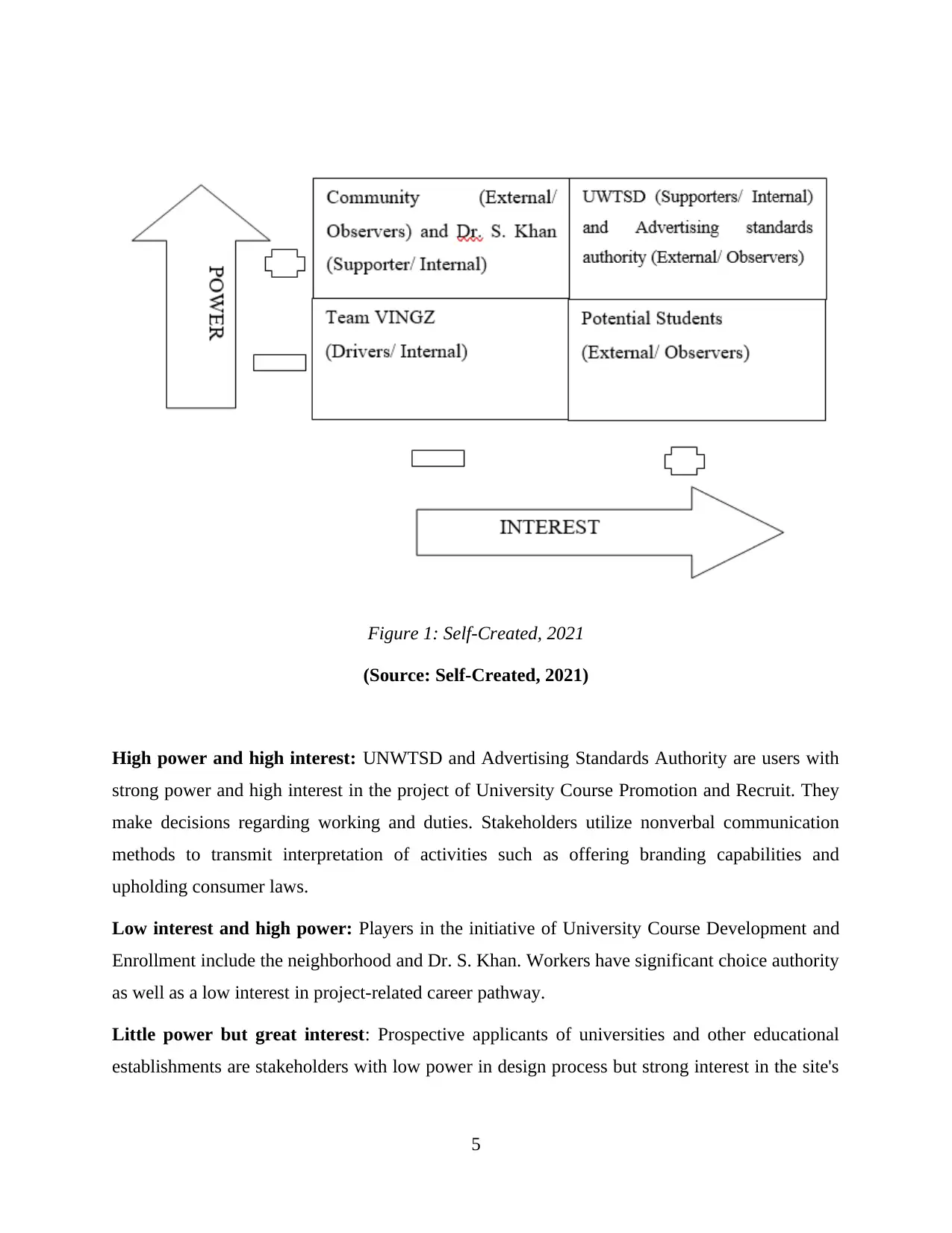
Figure 1: Self-Created, 2021
(Source: Self-Created, 2021)
High power and high interest: UNWTSD and Advertising Standards Authority are users with
strong power and high interest in the project of University Course Promotion and Recruit. They
make decisions regarding working and duties. Stakeholders utilize nonverbal communication
methods to transmit interpretation of activities such as offering branding capabilities and
upholding consumer laws.
Low interest and high power: Players in the initiative of University Course Development and
Enrollment include the neighborhood and Dr. S. Khan. Workers have significant choice authority
as well as a low interest in project-related career pathway.
Little power but great interest: Prospective applicants of universities and other educational
establishments are stakeholders with low power in design process but strong interest in the site's
5
(Source: Self-Created, 2021)
High power and high interest: UNWTSD and Advertising Standards Authority are users with
strong power and high interest in the project of University Course Promotion and Recruit. They
make decisions regarding working and duties. Stakeholders utilize nonverbal communication
methods to transmit interpretation of activities such as offering branding capabilities and
upholding consumer laws.
Low interest and high power: Players in the initiative of University Course Development and
Enrollment include the neighborhood and Dr. S. Khan. Workers have significant choice authority
as well as a low interest in project-related career pathway.
Little power but great interest: Prospective applicants of universities and other educational
establishments are stakeholders with low power in design process but strong interest in the site's
5
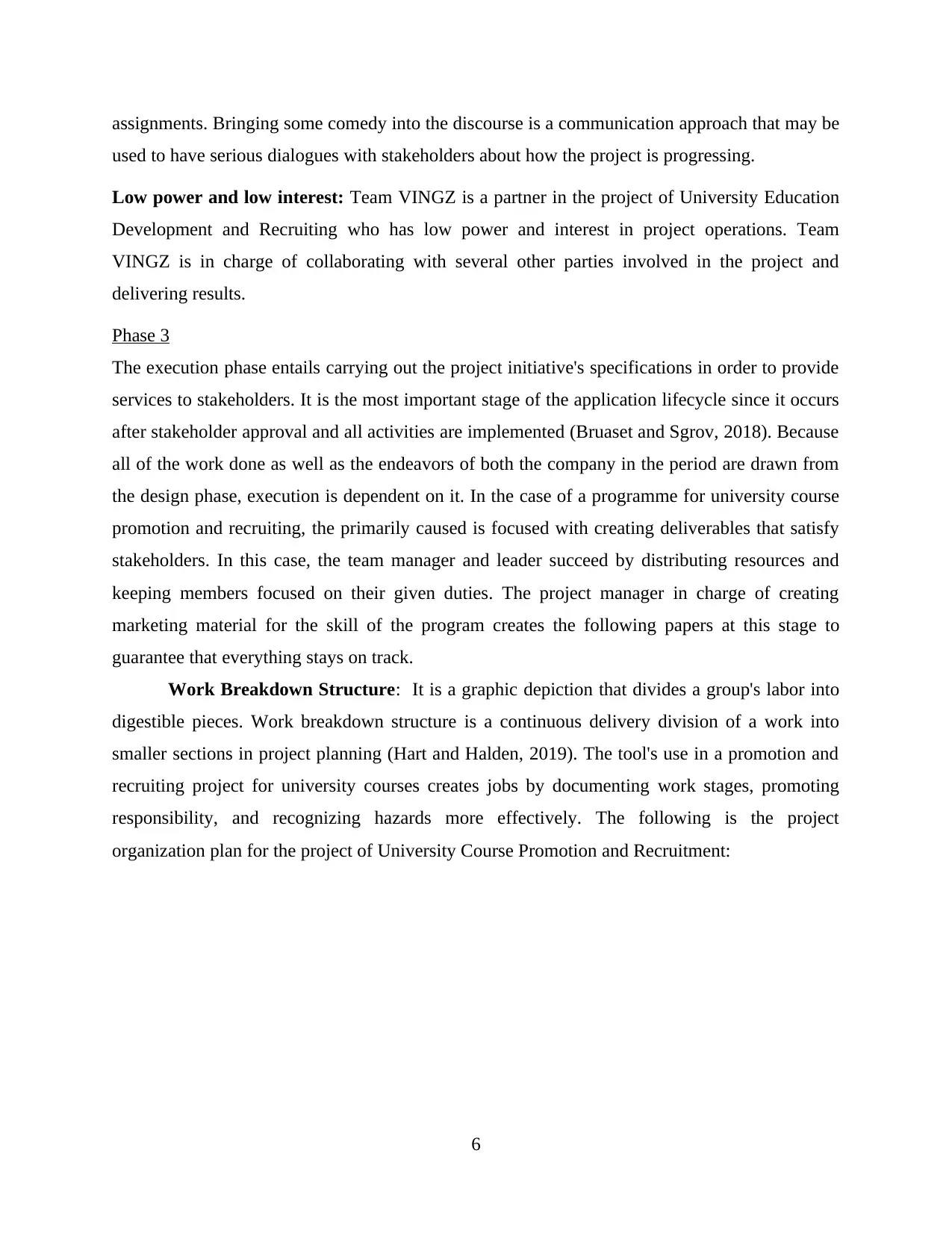
assignments. Bringing some comedy into the discourse is a communication approach that may be
used to have serious dialogues with stakeholders about how the project is progressing.
Low power and low interest: Team VINGZ is a partner in the project of University Education
Development and Recruiting who has low power and interest in project operations. Team
VINGZ is in charge of collaborating with several other parties involved in the project and
delivering results.
Phase 3
The execution phase entails carrying out the project initiative's specifications in order to provide
services to stakeholders. It is the most important stage of the application lifecycle since it occurs
after stakeholder approval and all activities are implemented (Bruaset and Sgrov, 2018). Because
all of the work done as well as the endeavors of both the company in the period are drawn from
the design phase, execution is dependent on it. In the case of a programme for university course
promotion and recruiting, the primarily caused is focused with creating deliverables that satisfy
stakeholders. In this case, the team manager and leader succeed by distributing resources and
keeping members focused on their given duties. The project manager in charge of creating
marketing material for the skill of the program creates the following papers at this stage to
guarantee that everything stays on track.
Work Breakdown Structure: It is a graphic depiction that divides a group's labor into
digestible pieces. Work breakdown structure is a continuous delivery division of a work into
smaller sections in project planning (Hart and Halden, 2019). The tool's use in a promotion and
recruiting project for university courses creates jobs by documenting work stages, promoting
responsibility, and recognizing hazards more effectively. The following is the project
organization plan for the project of University Course Promotion and Recruitment:
6
used to have serious dialogues with stakeholders about how the project is progressing.
Low power and low interest: Team VINGZ is a partner in the project of University Education
Development and Recruiting who has low power and interest in project operations. Team
VINGZ is in charge of collaborating with several other parties involved in the project and
delivering results.
Phase 3
The execution phase entails carrying out the project initiative's specifications in order to provide
services to stakeholders. It is the most important stage of the application lifecycle since it occurs
after stakeholder approval and all activities are implemented (Bruaset and Sgrov, 2018). Because
all of the work done as well as the endeavors of both the company in the period are drawn from
the design phase, execution is dependent on it. In the case of a programme for university course
promotion and recruiting, the primarily caused is focused with creating deliverables that satisfy
stakeholders. In this case, the team manager and leader succeed by distributing resources and
keeping members focused on their given duties. The project manager in charge of creating
marketing material for the skill of the program creates the following papers at this stage to
guarantee that everything stays on track.
Work Breakdown Structure: It is a graphic depiction that divides a group's labor into
digestible pieces. Work breakdown structure is a continuous delivery division of a work into
smaller sections in project planning (Hart and Halden, 2019). The tool's use in a promotion and
recruiting project for university courses creates jobs by documenting work stages, promoting
responsibility, and recognizing hazards more effectively. The following is the project
organization plan for the project of University Course Promotion and Recruitment:
6
⊘ This is a preview!⊘
Do you want full access?
Subscribe today to unlock all pages.

Trusted by 1+ million students worldwide
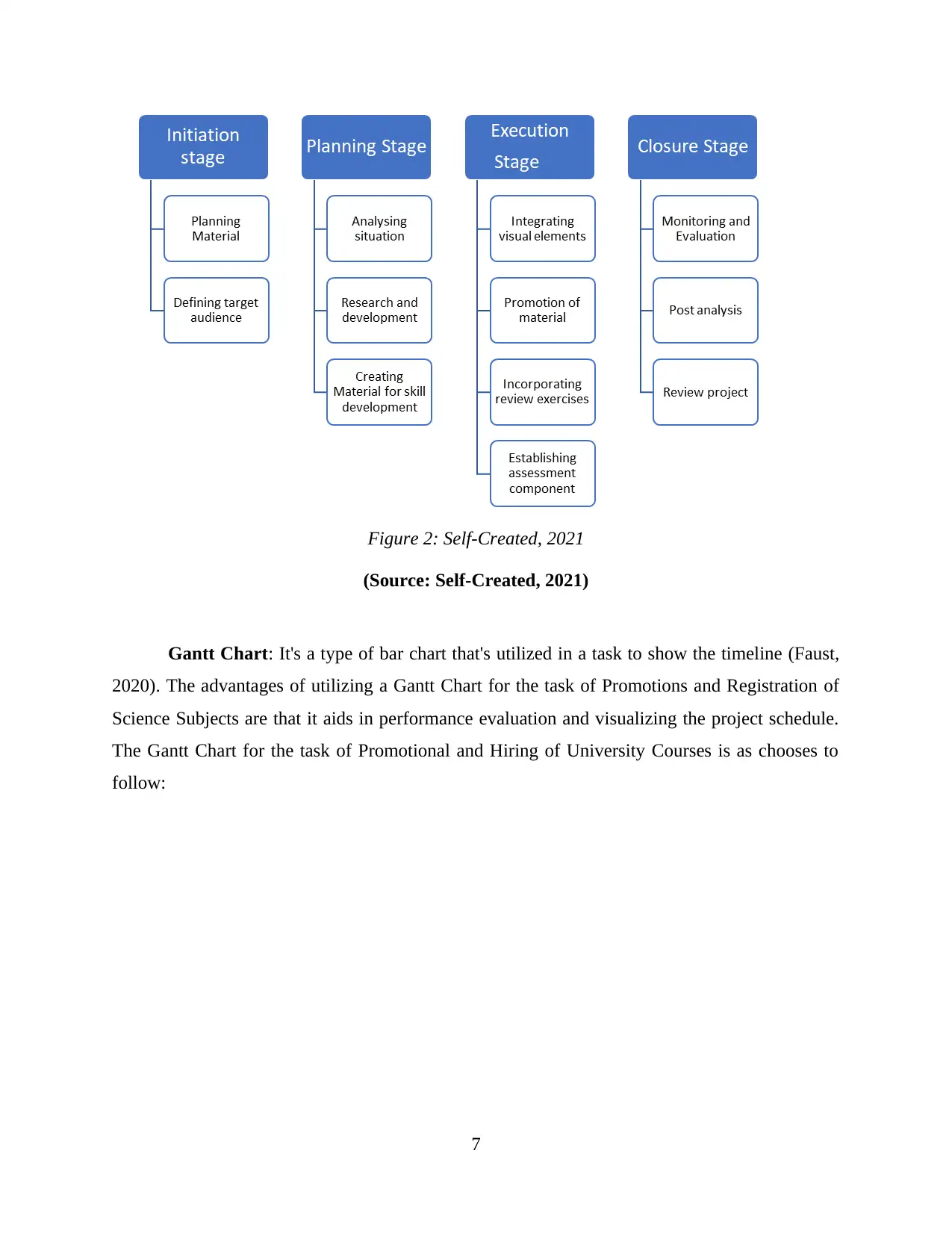
Figure 2: Self-Created, 2021
(Source: Self-Created, 2021)
Gantt Chart: It's a type of bar chart that's utilized in a task to show the timeline (Faust,
2020). The advantages of utilizing a Gantt Chart for the task of Promotions and Registration of
Science Subjects are that it aids in performance evaluation and visualizing the project schedule.
The Gantt Chart for the task of Promotional and Hiring of University Courses is as chooses to
follow:
7
(Source: Self-Created, 2021)
Gantt Chart: It's a type of bar chart that's utilized in a task to show the timeline (Faust,
2020). The advantages of utilizing a Gantt Chart for the task of Promotions and Registration of
Science Subjects are that it aids in performance evaluation and visualizing the project schedule.
The Gantt Chart for the task of Promotional and Hiring of University Courses is as chooses to
follow:
7
Paraphrase This Document
Need a fresh take? Get an instant paraphrase of this document with our AI Paraphraser
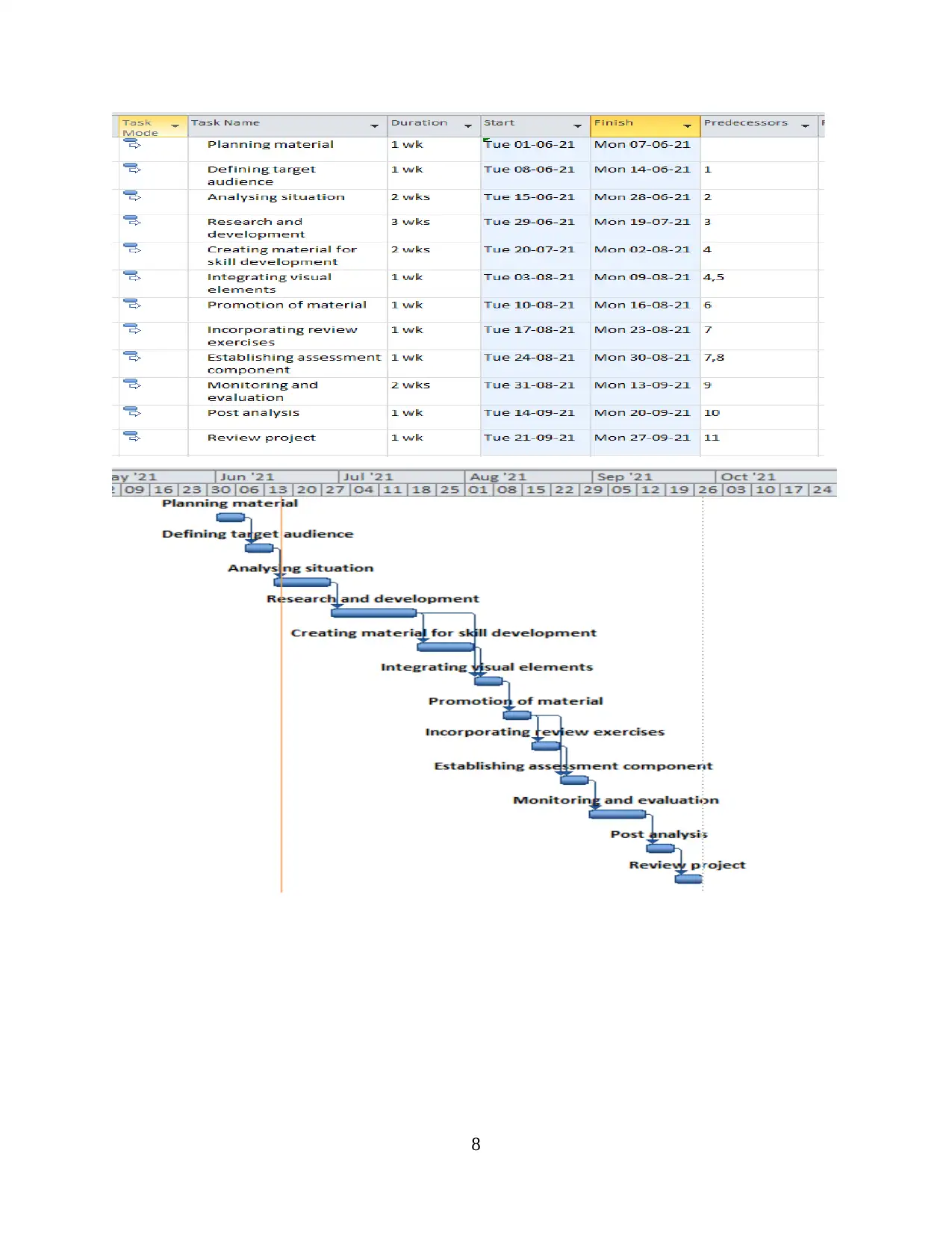
8
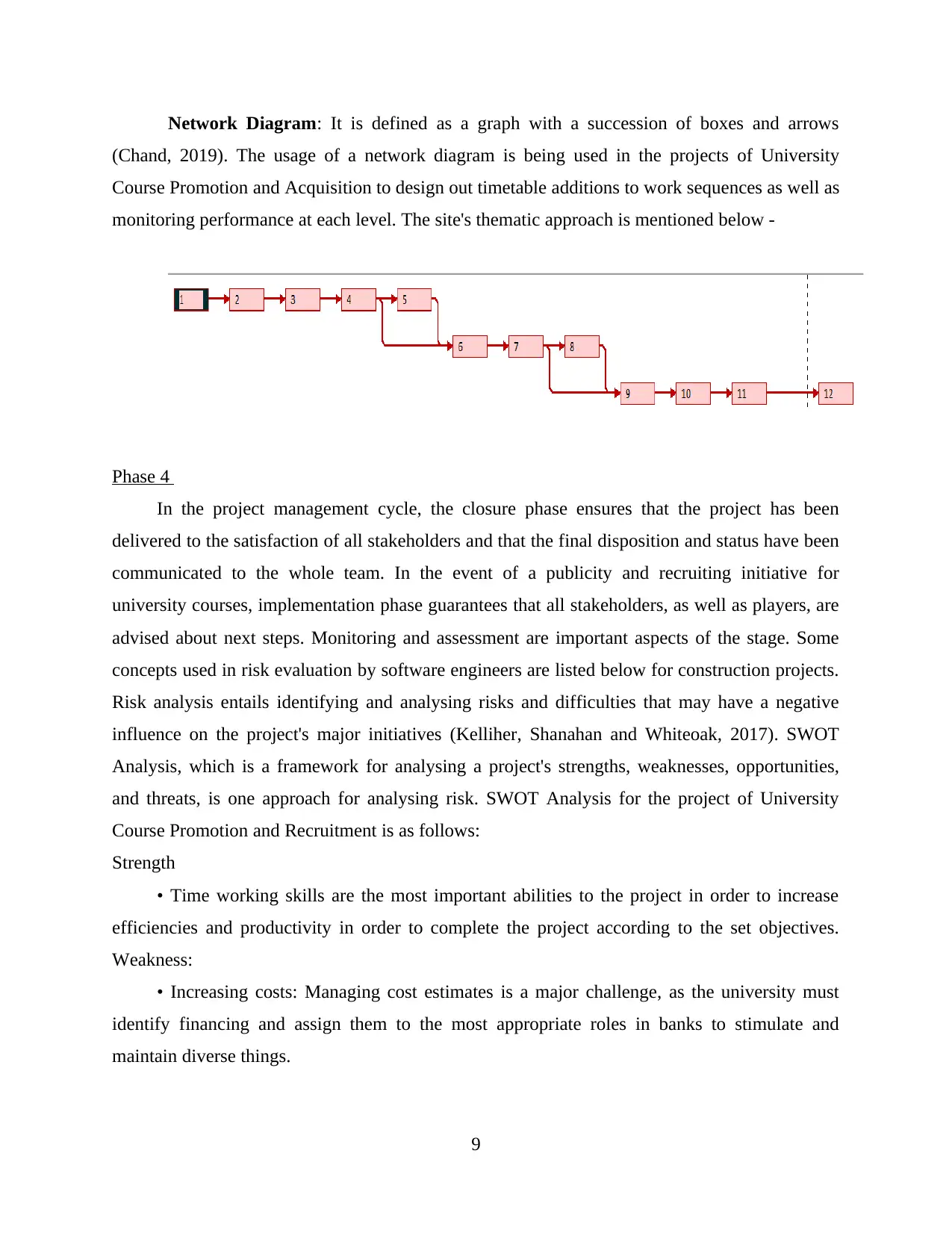
Network Diagram: It is defined as a graph with a succession of boxes and arrows
(Chand, 2019). The usage of a network diagram is being used in the projects of University
Course Promotion and Acquisition to design out timetable additions to work sequences as well as
monitoring performance at each level. The site's thematic approach is mentioned below -
Phase 4
In the project management cycle, the closure phase ensures that the project has been
delivered to the satisfaction of all stakeholders and that the final disposition and status have been
communicated to the whole team. In the event of a publicity and recruiting initiative for
university courses, implementation phase guarantees that all stakeholders, as well as players, are
advised about next steps. Monitoring and assessment are important aspects of the stage. Some
concepts used in risk evaluation by software engineers are listed below for construction projects.
Risk analysis entails identifying and analysing risks and difficulties that may have a negative
influence on the project's major initiatives (Kelliher, Shanahan and Whiteoak, 2017). SWOT
Analysis, which is a framework for analysing a project's strengths, weaknesses, opportunities,
and threats, is one approach for analysing risk. SWOT Analysis for the project of University
Course Promotion and Recruitment is as follows:
Strength
• Time working skills are the most important abilities to the project in order to increase
efficiencies and productivity in order to complete the project according to the set objectives.
Weakness:
• Increasing costs: Managing cost estimates is a major challenge, as the university must
identify financing and assign them to the most appropriate roles in banks to stimulate and
maintain diverse things.
9
(Chand, 2019). The usage of a network diagram is being used in the projects of University
Course Promotion and Acquisition to design out timetable additions to work sequences as well as
monitoring performance at each level. The site's thematic approach is mentioned below -
Phase 4
In the project management cycle, the closure phase ensures that the project has been
delivered to the satisfaction of all stakeholders and that the final disposition and status have been
communicated to the whole team. In the event of a publicity and recruiting initiative for
university courses, implementation phase guarantees that all stakeholders, as well as players, are
advised about next steps. Monitoring and assessment are important aspects of the stage. Some
concepts used in risk evaluation by software engineers are listed below for construction projects.
Risk analysis entails identifying and analysing risks and difficulties that may have a negative
influence on the project's major initiatives (Kelliher, Shanahan and Whiteoak, 2017). SWOT
Analysis, which is a framework for analysing a project's strengths, weaknesses, opportunities,
and threats, is one approach for analysing risk. SWOT Analysis for the project of University
Course Promotion and Recruitment is as follows:
Strength
• Time working skills are the most important abilities to the project in order to increase
efficiencies and productivity in order to complete the project according to the set objectives.
Weakness:
• Increasing costs: Managing cost estimates is a major challenge, as the university must
identify financing and assign them to the most appropriate roles in banks to stimulate and
maintain diverse things.
9
⊘ This is a preview!⊘
Do you want full access?
Subscribe today to unlock all pages.

Trusted by 1+ million students worldwide
1 out of 17
Related Documents
Your All-in-One AI-Powered Toolkit for Academic Success.
+13062052269
info@desklib.com
Available 24*7 on WhatsApp / Email
![[object Object]](/_next/static/media/star-bottom.7253800d.svg)
Unlock your academic potential
Copyright © 2020–2025 A2Z Services. All Rights Reserved. Developed and managed by ZUCOL.





